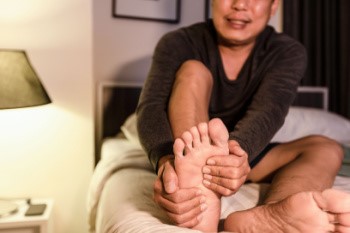
The Achilles tendon is the strongest tendon in the human body. Its purpose is to connect the lower leg muscles and calf to the heel of the foot. This tendon is responsible for facilitating all types of movement, like walking and running. This tendon provides an enormous amount of mobility for the body. Any injuries inflicted to this tissue should be immediately brought up with a physician to prevent further damage.
The most common injuries that can trouble the Achilles tendon are tendon ruptures and Achilles tendinitis. Achilles tendinitis is the milder of the two injuries. It can be recognized by the following symptoms: inflammation, dull-to-severe pain, increased blood flow to the tendon, thickening of the tendon, and slower movement time. Tendinitis can be treated via several methods and is often diagnosed by an MRI.
An Achilles tendon rupture is trickier to heal, and is by far the most painful injury. It is caused by the tendon ripping or completely snapping. The results are immediate and absolutely devastating, and will render the patient immobile. If a rupture or tear occurs, operative and non-operative methods are available. Once the treatment begins, depending on the severity of the injury, recovery time for these types of issues can take up to a year.
Simple preventative measures can be taken as a means to avoid both injuries. Prior to any movement, taking a few minutes to stretch out the tendon is a great way to stimulate the tissue. Calf raises, squats, leg curls, leg extensions, leg raises, lunges, and leg presses are all suggested ways to help strengthen the lower legs and promote Achilles tendon health.
Many problems arise among athletes and people who overexert themselves while exercising. Problems can also happen among those who do not warm up properly before beginning an activity. Proper, comfortable shoes that fit correctly can also decrease tendon injuries. Some professionals also suggest that when exercising, you should make sure that the floor you are on is cushioned or has a mat. This will relieve pressure on the heels. A healthy diet will also increase tendon health.
It is very important to seek out a podiatrist if you believe you have an injury in the Achilles region. Further damage could result in severe complications that would make being mobile difficult, if not impossible.

Diagnosing Achilles tendon ruptures involves a combination of clinical evaluation and imaging tests. The Achilles tendon, the largest tendon in the body, connects the calf muscles to the heel bone. A rupture occurs when this tendon tears, often due to sudden or forceful movements during sports or activities that place excessive stress on the tendon. Symptoms of an Achilles tendon rupture typically include a sudden, sharp pain in the back of the ankle or calf, accompanied by swelling and difficulty walking or standing on tiptoe. While this injury can happen to anyone, factors such as age, sports participation, and pre-existing foot problems like flat feet or tendonitis may increase the risk. Treatment options include conservative measures like immobilization to more advanced options, like surgical repair for severe cases. If you have injured your Achilles tendon, it is strongly suggested that you schedule an appointment with a podiatrist for an accurate diagnosis and treatment plan.
Achilles tendon injuries need immediate attention to avoid future complications. If you have any concerns, contact Dr. Robert Hope of Riverside Podiatry. Our doctor can provide the care you need to keep you pain-free and on your feet.
What Is the Achilles Tendon?
The Achilles tendon is a tendon that connects the lower leg muscles and calf to the heel of the foot. It is the strongest tendon in the human body and is essential for making movement possible. Because this tendon is such an integral part of the body, any injuries to it can create immense difficulties and should immediately be presented to a doctor.
What Are the Symptoms of an Achilles Tendon Injury?
There are various types of injuries that can affect the Achilles tendon. The two most common injuries are Achilles tendinitis and ruptures of the tendon.
Achilles Tendinitis Symptoms
Rupture Symptoms
Treatment and Prevention
Achilles tendon injuries are diagnosed by a thorough physical evaluation, which can include an MRI. Treatment involves rest, physical therapy, and in some cases, surgery. However, various preventative measures can be taken to avoid these injuries, such as:
If you have any questions please feel free to contact our office located in Tuscaloosa, and Fayette, AL . We offer the newest diagnostic tools and technology to treat your foot and ankle needs.
 Peripheral neuropathy, a complication of diabetes, occurs when high levels of fats or sugar in the blood damage nerves throughout the body, particularly in the extremities like the feet and hands. Symptoms include numbness, tingling, pain, and loss of sensation in these areas. Peripheral neuropathy often progresses gradually and can be unnoticed until its more advanced stages. Diagnosis involves a thorough physical examination by a podiatrist to assess reflexes, sensation loss, and skin changes. Additional tests like electromyograms, EMG, or nerve conduction velocity tests, abbreviated NCV, may be required for confirmation. While there is no cure for peripheral neuropathy, managing blood sugar levels is the best way to slow its progression. Treatment focuses on alleviating symptoms and preventing complications, such as ulcers. It is important to seek care from a podiatrist, a doctor who specializes in foot and ankle health, for comprehensive management of peripheral neuropathy. To help maintain mobility and prevent complications like ulcers and amputations, it is suggested that you include a podiatrist in your medical team.
Peripheral neuropathy, a complication of diabetes, occurs when high levels of fats or sugar in the blood damage nerves throughout the body, particularly in the extremities like the feet and hands. Symptoms include numbness, tingling, pain, and loss of sensation in these areas. Peripheral neuropathy often progresses gradually and can be unnoticed until its more advanced stages. Diagnosis involves a thorough physical examination by a podiatrist to assess reflexes, sensation loss, and skin changes. Additional tests like electromyograms, EMG, or nerve conduction velocity tests, abbreviated NCV, may be required for confirmation. While there is no cure for peripheral neuropathy, managing blood sugar levels is the best way to slow its progression. Treatment focuses on alleviating symptoms and preventing complications, such as ulcers. It is important to seek care from a podiatrist, a doctor who specializes in foot and ankle health, for comprehensive management of peripheral neuropathy. To help maintain mobility and prevent complications like ulcers and amputations, it is suggested that you include a podiatrist in your medical team.
Neuropathy
Neuropathy can be a potentially serious condition, especially if it is left undiagnosed. If you have any concerns that you may be experiencing nerve loss in your feet, consult with Dr. Robert Hope of Riverside Podiatry. Our doctor will assess your condition and provide you with quality foot and ankle treatment for neuropathy.
What Is Neuropathy?
Neuropathy is a condition that leads to damage to the nerves in the body. Peripheral neuropathy, or neuropathy that affects your peripheral nervous system, usually occurs in the feet. Neuropathy can be triggered by a number of different causes. Such causes include diabetes, infections, cancers, disorders, and toxic substances.
Symptoms of Neuropathy Include:
Those with diabetes are at serious risk due to being unable to feel an ulcer on their feet. Diabetics usually also suffer from poor blood circulation. This can lead to the wound not healing, infections occurring, and the limb may have to be amputated.
Treatment
To treat neuropathy in the foot, podiatrists will first diagnose the cause of the neuropathy. Figuring out the underlying cause of the neuropathy will allow the podiatrist to prescribe the best treatment, whether it be caused by diabetes, toxic substance exposure, infection, etc. If the nerve has not died, then it’s possible that sensation may be able to return to the foot.
Pain medication may be issued for pain. Electrical nerve stimulation can be used to stimulate nerves. If the neuropathy is caused from pressure on the nerves, then surgery may be necessary.
If you have any questions please feel free to contact our offices located in Tuscaloosa, and Fayette, AL. We offer the newest diagnostic and treatment technologies for all your podiatric needs.
Neuropathy is the weakness, numbness, and pain in the hands and feet due to damage to the peripheral nerves. The peripheral nerves are responsible for sending information from the brain and spinal cord to the rest of your body. Causes of Neuropathy include: traumatic injuries, infections, metabolic problems, exposure to toxins, and diabetes.
Diabetes is the most common cause, with more than half of the diabetic population developing some type of neuropathy. There are several types of neuropathy and they vary based on the damage of the nerves. Mononeuropathy is classified as only one nerve being damaged. When multiple nerves are affected, it is referred as polyneuropathy. One of the types of polyneuropathy is distal symmetric polyneuropathy. It is the most common for people with diabetes and starts when the nerves furthest away from the central nervous begin to malfunction. The symptoms begin with pain and numbness in the feet and then they travel up to the legs. A rarer form of polyneuropathy is acute symmetrical peripheral neuropathy, which is a severe type that affects nerves throughout the body and is highly associated with Guillain-Barre syndrome, an autoimmune disorder that attacks the peripheral nervous system and can be fatal. Although there are many types of neuropathy, most of them share the same symptoms such as pain, extreme sensitivity to touch, lack of coordination, muscle weakness, dizziness, and digestive problems. Since neuropathy affects the nerves, those affected should be careful of burns, infection and falling, as depleted sensations disguise such ailments.
The best way to prevent neuropathy is to manage any medical conditions such as diabetes, alcoholism, or rheumatoid arthritis. Creating and managing a healthy lifestyle can also go a long way. Having a healthy diet full of fruits, vegetables, whole grains and lean protein can keep the nerves healthy. These types of food have the nutrients to prevent neuropathy. Regularly exercising can help as well, but it is best to consult with a doctor about the right amount. In addition to diet and exercise, avoiding risk factors will also prevent neuropathy. This includes repetitive motions, cramped positions, exposure to toxic chemicals, smoking and overindulging on alcohol.
 Heel spur surgery stands as a significant decision for those grappling with persistent heel pain. Understanding the procedure's intricacies unveils vital insights. The surgery involves excising the bony protrusion from the heel bone, often performed under local or general anesthesia. It typically necessitates a recovery period, during which mobility may be limited, demanding patience and adherence to post-operative instructions. Complications such as infection or nerve damage, though rare, underscore the importance of meticulous post-operative care. The decision to undergo surgery hinges on various factors, including the severity of symptoms and the efficacy of non-surgical interventions. Consulting with a podiatrist is essential for informed decision-making, as they can provide tailored guidance based on individual circumstances. While heel spur surgery offers relief for many, it is important to approach it with a thorough understanding of the process, potential outcomes, and commitment to recovery. If you have a heel spur that is causing pain, it is strongly suggested that you confer with a podiatrist who can determine if heel spur surgery is right for you.
Heel spur surgery stands as a significant decision for those grappling with persistent heel pain. Understanding the procedure's intricacies unveils vital insights. The surgery involves excising the bony protrusion from the heel bone, often performed under local or general anesthesia. It typically necessitates a recovery period, during which mobility may be limited, demanding patience and adherence to post-operative instructions. Complications such as infection or nerve damage, though rare, underscore the importance of meticulous post-operative care. The decision to undergo surgery hinges on various factors, including the severity of symptoms and the efficacy of non-surgical interventions. Consulting with a podiatrist is essential for informed decision-making, as they can provide tailored guidance based on individual circumstances. While heel spur surgery offers relief for many, it is important to approach it with a thorough understanding of the process, potential outcomes, and commitment to recovery. If you have a heel spur that is causing pain, it is strongly suggested that you confer with a podiatrist who can determine if heel spur surgery is right for you.
Foot surgery is sometimes necessary to treat a foot ailment. To learn more, contact Dr. Robert Hope of Riverside Podiatry. Our doctor will assist you with all of your foot and ankle needs.
When Is Surgery Necessary?
Foot and ankle surgery is generally reserved for cases in which less invasive, conservative procedures have failed to alleviate the problem. Some of the cases in which surgery may be necessary include:
What Types of Surgery Are There?
The type of surgery you receive will depend on the nature of the problem you have. Some of the possible surgeries include:
Benefits of Surgery
Although surgery is usually a last resort, it can provide more complete pain relief compared to non-surgical methods and may allow you to finally resume full activity.
Surgical techniques have also become increasingly sophisticated. Techniques like endoscopic surgery allow for smaller incisions and faster recovery times.
If you have any questions please feel free to contact our offices located in Tuscaloosa, and Fayette, AL. We offer the newest diagnostic and treatment technologies for all your podiatric needs.
Read More About Foot Surgery
In most cases, foot surgery is often chosen as the last available option for conditions that have otherwise been unsuccessfully treated. Surgery may be necessary for several reasons, including the removal of foot deformities (e.g. bone spurs or bunions), arthritis problems, reconstruction due to injury, and congenital malformations (e.g. club foot or flat feet). Regardless of one’s age, foot surgery may be the only successful option for treatment for certain conditions.
The type of surgery one undergoes depends on the type of foot condition the patient has. For the removal of a bunion growth, a bunionectomy is necessary. If the bones in the feet need to be realigned or fused together, a surgical fusion of the foot is needed. For pain or nerve issues, a patient may require surgery in which the tissues surrounding the painful nerve are removed. Initially, less invasive treatments are generally attempted; surgery is often the last measure taken if other treatments are unsuccessful.
While in many cases surgery is often deemed as the final resort, choosing surgery comes with certain benefits. The associated pain experienced in relation to the particular condition is often relieved with surgery, allowing patients to quickly resume daily activities. The greatest benefit, however, is that surgery generally eliminates the problem immediately.
Podiatry history has shown that foot treatments continue to evolve over time. In the field of foot surgery, endoscopic surgery is just one of the many advanced forms of surgery. As technology vastly improves so too will the various techniques in foot surgery, which already require smaller and smaller incisions with the use of better and more efficient tools. Thanks to such innovations, surgery is no longer as invasive as it was in the past, allowing for faster and easier recoveries.